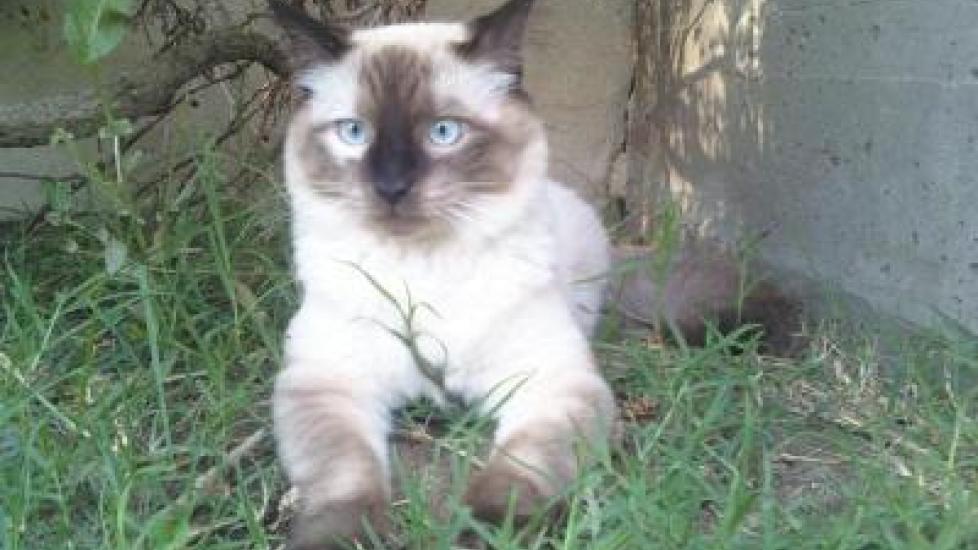Balinese
Physical Characteristics
In the initial years of breeding, the Balinese had heavier bones and apple shaped heads, more akin to the former standard Siamese. They also had much longer coats than the Balinese breed today, with full ruffs and britches. Over the years, Balinese breeders have improved the physical form of the breed by outcrossing it with the parent breed, the Siamese, and the features of the Balinese have become leaner and longer, just as the modern Siamese has. The breed standard for the Balinese is identical to the standard for the Siamese in most respects, including overall body type and color, with the obvious differences being in overall coat length, and in the full plume tail. The coat is single coated, with only minimal shedding. In fact, the Balinese is noted for its lack of shedding amongst long coated cats.
The coat on the contemporary Balinese is of a silky texture, medium length and lying close to the body. This breed is typified by a long and tapering form, with softer lines than the Siamese owing to the fuller coat. It is both dainty and muscular. The head is wedge shaped, the eyes slanted and vivid blue, the ears are remarkably large, open and pointed, and the profile is linear. Colors are standard with the Siamese as well: seal point, blue point, lilac point, and chocolate point.
The general life span for the Balinese is 18-22 years, and with the exception of crossed eyes, this breed is not particularly known for any serious physical defects.
Personality and Temperament
In personality, the Balinese is also very much like its parent breed. Speaking and interacting with humans is what it is most fond of. This breed is ranked as one of the most intelligent of cat breeds, and is also remarkable for its good humor, good nature, and high energy. Getting along well with both animals and people is one of the strongest qualities the Balinese possess. Its intelligence naturally pushes it to the top of the hierarchy amongst other animals, but it is amiable enough not to lord its superiority over them. Getting along with children is also one of the main pluses, but care must be taken not to allow active children to mishandle them, lest child-averse behavior form.
It is said that a Balinese can sense the mood of its humans, showing affection and staying close when people are blue. Although the demeanor of this cat is of an independent and reserved style, it is most content when being loved by a human. These cats also love to play, reveling in a good game of fetch, and back and forth ball play. Having a home that is friendly for jumping and climbing is a practical consideration for the Balinese fancier. Objects of value should not be displayed on open shelves, and silk curtains are certain to be frayed. The Balinese is well suited for indoor life, but the main concern is of a practical nature, since outdoor cats are more at risk of injury, illness, and abduction.
History and Background
One of the unfortunate consequences of any war is the resultant depopulation of domestic animals. So it was that in the course of World War I, the Siamese cat breed (along with most breeds) suffered terribly due to lack of attention and warfare. What typically must occur after the effects of wartime have decimated an animal population is that breeders must do the best they can, with what they have, to rebuild the all but lost breeds. Often, a breeder will choose the best match to the breed, and from there will choose the best of each subsequent litter, in the hopes of not only rebuilding a breed, but improving upon it, even. Crossing is a little spoken fact of breeding, and as often as not, the breeds used in the process are not recorded. Many times, breeders will insist that variations have naturally occurred, when in fact variations are directly linked to cross-breeding.
So it was with the Balinese breed, offspring to the Siamese. Long haired variations that were born of crossings were either discarded or petted out until the early 20th Century, when in 1928 the Cat Fanciers Association (CFA) registered a longhair Siamese. Another war would come and go before the "longhair Siamese," as it was termed, would begin to take the notice of breeders. Three breeders, Marion Dorsey, of the Rai-Mar Cattery in California, Helen Smith, of the Merry Mews Cattery in New York, and Sylvia Holland, of Holland's Farm Cattery in California, would be instrumental in the direction and success of the longhair Siamese breeding program. Over the next several years, the breeders worked in concert to perfect the new breed, happily finding that when they bred two longhair Siamese, the litters were true to the long coat trait.
Cat fanciers tend to be inclusive circlets within the larger cat fancy circle, and Siamese fanciers are no exception. Siamese breeders were opposed to the new breed being called a Siamese, inspiring Helen Smith to crown this longhair Siamese the Balinese – by most accounts, a name taken from the famed dancers of Bali, and perhaps Ms. Smith wanted to retain the sonant likeness to the Siamese name. All agree that the Balinese breed is indeed as graceful as a dancer, with a soft and rhythmic ease of movement.
Finally, after the Balinese was shown at the Empire Cat Show in New York in 1961, under the Any Other Variety (AOV) heading, the breed began to gain acceptance and was allowed championship status by most American cat associations. By 1970, when the Cat Fanciers Association (CFA) granted the Balinese championship status, the Balinese had a firm standard and a loyal following.
See More:
Help us make PetMD better
Was this article helpful?
